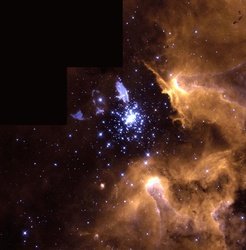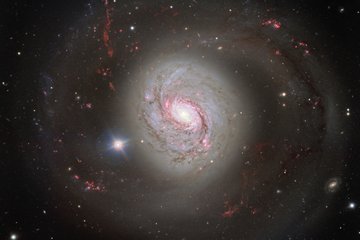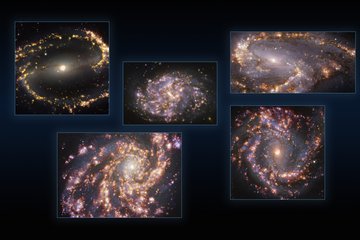Young Stellar Clusters

The majority of stars are born in stellar clusters. Focal points of our research are the determination of key properties of stellar populations in clusters like multiplicity, upper (or lower) mass limits in the stellar mass function, cluster dynamics and kinematics (derived from precise multi-epoch astrometric measurements), understanding the impact of the ionising radiation from hot massive stars on the formation and early evolution of low-mass stars (disk dispersal time scales and planet formation), and a better understanding of the physical processes leading to the formation of the most massive stellar clusters. While a multitude of low- and high-mass star formation sites can be studied in the solar neighbourhood, these sites cover only a small subset of all possible star formation modes and environments.
8 to 10m-class ground-based telescopes, the Very Large Telescope Interferometer, and the James Webb Space Telescope, all equipped with sensitive infrared instruments, facilitate studies of the stellar populations in massive clusters down to substellar masses throughout the Milky Way as well as in nearby Local Group galaxies.
Our studies also include nearby clusters like the Hyades, where we compiled a concise catalogue of binary and single star, which facilitate a better understanding of the dynamical evolution of the Hyades. The Hyades single star sequence also serves as a powerful benchmark to test and calibrate theoretical stellar evolutionary and atmospheric models.
The most massive star formation sites in the Milky Way like the Carina Nebula, the spiral arm Giant HII regions NGC 3603 and W49, and the Galactic Center region with its twin starburst cluster Arches and Quintuplet, and the central nuclear cluster are all located in the Galactic plane at distances between 2 to more than 10 kpc from the Sun. Because of the high stellar density and large dust column densities, these studies require high-angular resolution observations (to overcome crowding) and observations in the infrared (to overcome the extinction by dust grains). In all of these regions there is strong evidence for massive stars with masses in excess of 100 times the mass of the Sun.
The GRAVITY and MATISSE 2nd generation of instruments for the Very Large Telescope Interferometer also facilitate detailed studies of individual massive stars, including measurements of their physical diameters and shapes, and spatially resolved studies of their winds and outflows. While there is a multitude of low- and high-mass star formation sites in the Milky Way, these sites all have in common a metallicity (degree of enrichment by heavy elements) similar to the solar metallicity.
Extragalactic star-forming regions offer the unique opportunity to study star formation at different metallicities. The metallicity and the amount of dust has a strong impact on the physical and chemical properties of any star formation site and for extragalactic star formation sites the enormous input of energy into the surrounding interstellar medium by the hot and luminous stars in form of stellar winds or supernovae explosions can in principle strongly alter the star formation process.












